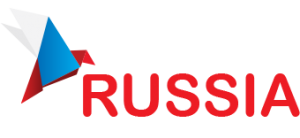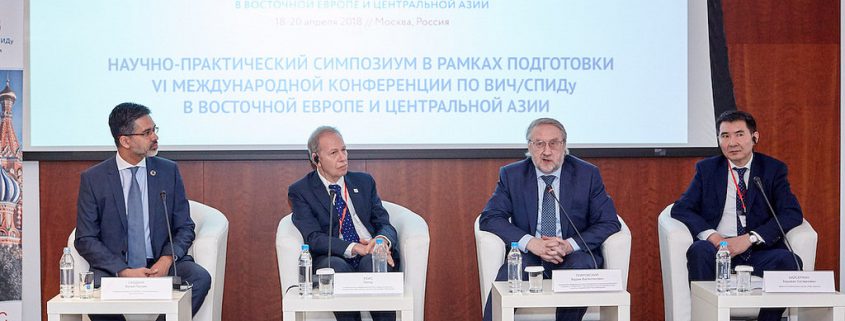EECAAC-2018 HIV Symposium Summaries (21.02.17)
Within the framework of the 6th Eastern Europe and Central Asia AIDS Conference, a symposium covering scientific and practical aspects of HIV/AIDS was held in Moscow, Russia on February 21, 2017. The goal of this symposium was the transfer of information and discussion about current approaches to prevention, treatment and access to treatment for HIV infection. Attendees included experts from the AIDS Centers of the countries of the Eastern Europe and Central Asia (EECA) region, as well as specialists from Rospotrebnadzor, scientific-research institutes, AIDS-related NGOs, organizations in the United Nations system, and other interested parties.
Much of the discussion was around the 90-90-90 strategy. According to UNAIDS, 90-90-90 is a strategic target to help end the AIDS epidemic. Specifically, the goals are laid out as: “By 2020, 90% of all people living with HIV will know their HIV status. By 2020, 90% of all people with diagnosed HIV infection will receive sustained antiretroviral therapy. By 2020, 90% of all people receiving antiretroviral therapy will have viral suppression.”
Session #1: Real approaches to the fight against HIV/AIDS on the global and regional level
Dr. Peter Reiss, Professor of Medicine the Academic Medical Center in Amsterdam and the Director of the HIV Monitoring Foundation, presented information about the monitoring of HIV in the Netherlands, primarily about the activities of the HIV Monitoring Foundation. The work of this organization is centered around five main activities:
- Monitoring trends in HIV by collecting data
- Creating models
- Monitoring quality of treatment and care
- Contributing to national and international research
- Acting as national reference center
In 2015, there were 900 people newly diagnosed in the Netherlands. Current trends include:
- Many of these new infection are in migrants
- 25% of newly diagnosed people are over 50 years old
- Approximately 45% of newly diagnosed people already had AIDS
- HIV/AIDS in the Netherlands is concentrated in cities, as is the case in most of the world
Given these statistics, Dr. Reiss says that expanded testing needed to improve earlier diagnosis. Specifically, there is a focus on proactive testing of ethnic minorities. In addition, attention is needed to the complexities of age-related comorbidities (such as cardiovascular disease) in people with HIV.
The approach to treatment with ART in the Netherlands is to start treatment as soon as possible, regardless of CD4 count. Almost everyone starts treatment within 6 months of diagnosis with HIV. Fully half of newly diagnosed people start taking ART within one month of diagnosis.
Panelist Vadim Valentinovich Pokrovsky, Head of the Russian Federal AIDS Center of the Rospotrebnadzor Central Research Institute of Epidemiology, provided some Russian perspective by saying that attention is needed to access to treatment and quality of treatment. He acknowledged that he sees very hard work ahead to get to where the Netherlands is in terms of treatment.
Panelist Luiz Loures, Deputy Executive Director of Programme and Assistant Secretary-General of the United Nations, made 3 points: 1) the EECA region has been left behind by international community; 2) although there more progress than ever before, it is crucial that everyone has access to the scientific advances; and 3) 90-90-90 only makes sense if you apply it to vulnerable populations – MSM, CSW, IDU – we need to get more specific, as general education is not really helpful.
Session #2 Real questions about treatment (latest recommendations of the WHO)
Dr. Gottfried Hirnschall, Director of the HIV/AIDS Department and the Global Hepatitis Programme (GHP) of the World Health Organization, laid out the global HIV/AIDS treatment situation. His statistics included the following:
- Around 19 million people are currently receiving ART now (18,2 mln by mid 2016); in 2020, there is goal to be treating 30 million and a 2030 goal of 33 million on ART
- Mortality from AIDS in 2005 was 2 million people; in 2015 1.1 million people died; in 2020, it is expected that <500,000 will die, and in 2030 <400,000 will die from AIDS
- The progress towards the 90-90-90 targets globally is currently at 60-46-38, while in Russia it is 61-18-15
He summarized the current treatment recommendations as:
- Treat all as soon as possible
- Use best class of drugs, optimized regimens, fixed dose regimens
- Task shifting, decentralization and integration to increase access
- Offer pre-exposure prophylaxis as additional approach to prevention
Panelist Renet van der Waals, Head of the Health and AIDS Division, Department for Social Development of the Ministry of Foreign Affairs, Netherlands, emphasized that access to treatment for all people is an important issue. If we don’t manage to reach all people globally, we will not be able eliminate the epidemic from the world.
Session #3 Latest recommendations of the WHO around HIV prevention and testing, including pre-exposure prophylaxis and self-testing for HIV
Elena Victorovna Vovk, Specialist of the Program for the control of TB, HIV and viral hepatitis of the European regional office of the WHO, discussed the positive aspects and logistics of self-testing. Typically, the test uses saliva and gives a result after 20 minutes. If the test is positive, the person is urged to see a specialist for confirmatory testing and to start on treatment. If the test is negative, retesting is recommended if there was contact with someone suspected of having HIV or if the person has a reason to doubt the results. The sensitivity of these tests is 96.6-99.5%, while the specificity is 99.9-100.00%. In Europe, where self-testing is widely available, there is 70->80% acceptance.
Dr. Vovk also touched upon the latest recommendations of the WHO around the use of pre-exposure prophylaxis (PREP). She said that PREP was for specific vulnerable groups of the population and only to be used as an additional form of prevention among these groups, who should also be offered other forms of prevention methods, such as condoms, harm reduction and testing. It should only be offered with necessary support, including: counseling on adherence, legal and social support, mental health and emotional support and contraceptive and reproductive health services.
Panelist Natalia Nikolaevna Ladnaya, Senior Scientific Officer of the Russian Federal AIDS Center of Rospotrebnadzor Central Research Institute of Epidemiology, offered the Russian perspective on self-testing and pre-exposure prophylaxix (PREP).
Dr. Ladnaya reported that in 2015, 30 million HIV tests were done in Russia. Currently, self-tests are already available in Russia. However, instructions that come with the test say that they should be done by medical personnel. One potential downside to the tests are that there is no pre/post-test counseling.
She said that some of the main concerns around PREP include the question of how can one ethically offer this to commercial sex workers instead of condoms? Should the government pay for PREP? What are the implications around potential resistance?
Session #4 Discussion of the regulations of the market for ARV and mechanisms for increasing access to treatment
Luiz Mendao, Treatment Activist Group, European AIDS Treatment Group, provided some interesting perspectives on access to ARV treatment, including personal insight, as he has been taking ARV treatment for 22 years.
He focused on Russia, saying that if there are currently 1.2 million people living with HIV/AIDS in the country, we can assume that there will be 1.4 million people living with HIV/AIDS in Russia by 2020. In this case, there should be 1 million people on ARVs by the end of 2020, a number achievable if 190,000 people start treatment annually.
He furthered his point by saying that not only does the health of the individual benefit from starting ARV treatment immediately, but that there is a benefit to public health, as further transmission is prevented due to suppressed viral load from treatment.
As far as supply is concerned, Luiz says that producing the ARV needed by the 1.5 million people in the EECA region should present no problem (for reference, 17 million people were on ARV treatment globally at the end of 2015).
The benefits of newer ARV regimens include:
- Lower doses required
- Highly efficient
- Safer
- Tolerated much better
- Costs will be lower
Session #5: “90-90-90 Strategy: Is this a reasonable target of ART effectiveness?”
Yevgeny Konstantinovich Bukin, Medical Director, ViiV Healthcare Russia/CIS, discussed the evolution of HIV treatment with ART through the years and the current state of ART. He listed the goals of ART as: minimizing toxicity, drug interactions and viral resistance and maximizing effectiveness.
He discussed one drug, Dolutegravir (DTG), which is an integrase strand transfer inhibitor (INSTI), for use in combination with other anti-retroviral medicinal products. He presented some data from 3041 patients in five phase III clinical trials, which indicated that the addition of DTG to various ART regimens improved response to these regimens in terms of viral suppression.
DTG met the goals of the company by: increasing the effectiveness of ART regimens, preventing resistance, increasing tolerability and preventing treatment interruption, and was easy to take (tablets are small and can be taken with or without food).



